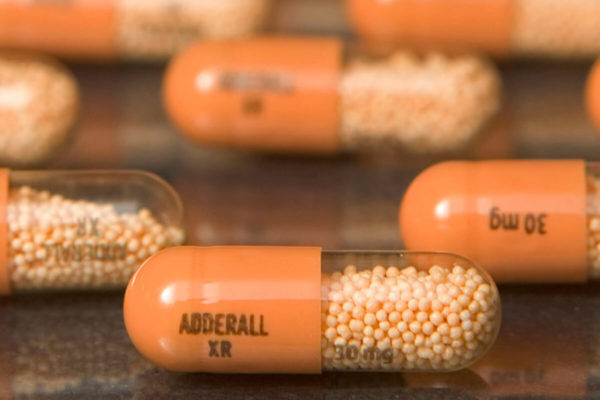Amphetamine / Dextroamphetamine | Adderall | Adderall XR
Adderall® is indicated for the treatment of Attention Deficit Hyperactivity Disorder (ADHD) and Narcolepsy. ADDERALL XR® is indicated for the treatment of attention deficit hyperactivity disorder (ADHD).
A diagnosis of ADHD (DSM-IV) implies the presence of hyperactive-impulsive or inattentive symptoms that caused impairment and were present before age 7 years. The symptoms must cause clinically significant impairment, e.g., in social, academic, or occupational functioning, and be present in two or more settings, e.g., school (or work) and at home. The symptoms must not be better accounted for by another mental disorder. For the Inattentive Type, at least six of the following symptoms must have persisted for at least 6 months: lack of attention to details/careless mistakes; lack of sustained attention; poor listener; failure to follow through on tasks; poor organization; avoids tasks requiring sustained mental effort; loses things; easily distracted; forgetful. For the Hyperactive-Impulsive Type, at least six of the following symptoms must have persisted for at least 6 months: fidgeting/squirming; leaving seat; inappropriate running/climbing; difficulty with quiet activities; “on the go;” excessive talking; blurting answers; can’t wait turn; intrusive. The Combined Type requires both inattentive and hyperactive-impulsive criteria to be met.

—–INDICATIONS AND USAGE—–
ADDERALL XR, a CNS stimulant, is indicated for the treatment of attention deficit hyperactivity disorder (ADHD).
- Children (ages 6-12): Efficacy was established in one 3-week outpatient, controlled trial and one analogue classroom, controlled trial in children with ADHD.
- Adolescents (ages 13-17): Efficacy was established in one 4- week controlled trial in adolescents with ADHD.
- Adults: Efficacy was established in one 4-week controlled trial in adults with ADHD.
—–DOSAGE AND ADMINISTRATION—–
- Pediatric patients (ages 6-17): 10 mg once daily in the morning. The maximum dose for children 6-12 is 30 mg once daily.
- Adults: 20 mg once daily in the morning.
—–DOSAGE FORM AND STRENGTHS—–
- Capsules: 5 mg, 10 mg, 15 mg, 20 mg, 25 mg, 30 mg
—–CONTRAINDICATIONS—–
- Advanced arteriosclerosis
- Symptomatic cardiovascular disease
- Moderate to severe hypertension
- Hyperthyroidism
- Known hypersensitivity or idiosyncrasy to the sympathomimetic amines
- Glaucoma
- Agitated states
- History of drug abuse
- During or within 14 days following the administration of monoamine oxidase inhibitors (MAOI)
—–WARNINGS AND PRECAUTIONS—–
- Serious Cardiovascular Events: Sudden death has been reported with usual doses of CNS stimulants in children and adolescents with structural cardiac abnormalities or other serious heart problems; sudden death, stroke, and myocardial infarction have been reported in adults taking CNS stimulants at usual doses. Stimulant drugs should not be used in patients with known structural cardiac abnormalities, cardiomyopathy, serious heart rhythm abnormalities, coronary artery disease, or other serious heart problems.
- Increase in Blood Pressure: Monitor blood pressure and pulse at appropriate intervals. Use with caution in patients for whom blood pressure increases may be problematic.
- Psychiatric Adverse Events: Stimulants may cause treatmentemergent psychotic or manic symptoms in patients with no prior history, or exacerbation of symptoms in patients with pre-existing psychosis. Evaluate for bipolar disorder prior to stimulant use. Monitor for aggressive behavior.
- Long-term Suppression of Growth: Monitor height and weight at appropriate intervals.
- Seizures: May lower the convulsive threshold. Discontinue in the presence of seizures.
- Peripheral Vasculopathy, including Raynaud’s phenomenon: Stimulants used to treat ADHD are associated with peripheral vasculopathy, including Raynaud’s phenomenon. Careful observation for digital changes is necessary during treatment with ADHD stimulants.
- Visual Disturbance: Difficulties with accommodation and blurring of vision have been reported with stimulant treatment.
- Tics: May exacerbate tics. Evaluate for tics and Tourette’s syndrome prior to stimulant administration. (5.7)
—–ADVERSE REACTIONS—–
- Children (ages 6 to 12): Most common adverse reactions (≥5% and with a higher incidence than on placebo) were loss of appetite, insomnia, abdominal pain, emotional lability, vomiting, nervousness, nausea, and fever.
- Adolescents (ages 13 to 17): Most common adverse reactions (≥5% and with a higher incidence than on placebo) were loss of appetite, insomnia, abdominal pain, weight loss, and nervousness.
- Adults: Most common adverse reactions ≥5% and with a higher incidence than on placebo were dry mouth, loss of appetite, insomnia, headache, weight loss, nausea, anxiety, agitation, dizziness, tachycardia, diarrhea, asthenia, and urinary tract infections.
—–DRUG INTERACTIONS—–
- MAOI antidepressants are contraindicated; MAOIs potentiate the effects of amphetamine. Do not administer ADDERALL XR during or within 14 days after use of MAOI.
- Alkalinizing agents (GI antacids and urinary): These agents increase blood levels of amphetamine.
- Acidifying agents (GI and urinary): These agents reduce blood levels of amphetamine.
- Adrenergic blockers, antihistamines, antihypertensives, phenobarbital, phenytoin, veratrum alkaloids, and ethosuximide: Effects may be reduced by amphetamines.
- Tricyclic antidepressants, norepinephrine, and meperidine: Effects may be potentiated by amphetamines.
—–USE IN SPECIFIC POPULATIONS—–
- Pregnancy: Use only if the potential benefit justifies the potential risk to the fetus. Based on animal data, may cause fetal harm.
- Nursing Mothers: should refrain from breastfeeding.
- Pediatric Use: has not been studied in children under 6 years of age.
- Geriatric Use: has not been studied in geriatric patients.

